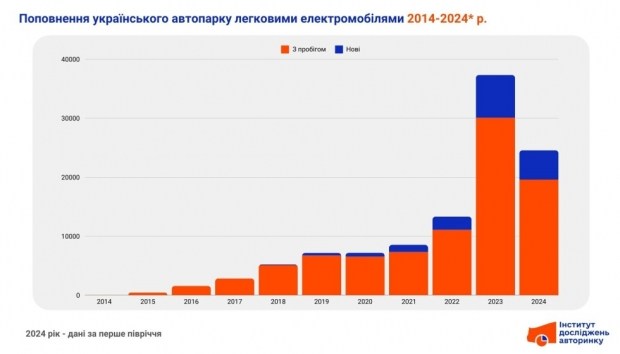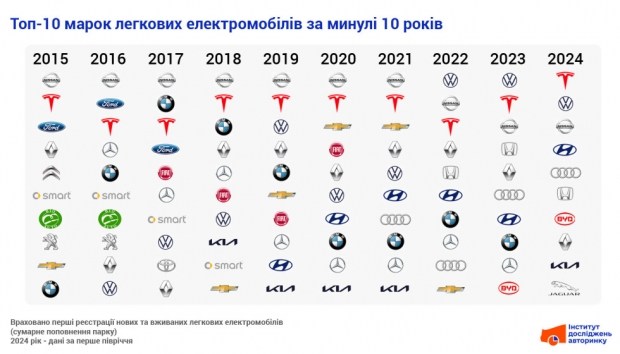The segment of electric cars is the youngest of all on the Ukrainian car market, it is literally just now being formed, which makes observing these processes extremely interesting. Based on the statistics of the first registrations of electric cars, specialists of the Institute of Car Market Research identified the ten most popular brands in the past years, which replenished our car fleet.
Currently, the Ukrainian fleet has more than 112,000 BEV (Battery Electric Vehicle) vehicles, of which about 110,000 are passenger cars. This is quite a lot – for example, in Poland (as of the end of May 2024, according to data from the SAMAR agency), there were 66.3 thousand electric cars in total, of which 59.7 thousand were passenger cars. So, despite all the difficulties of various kinds, the Ukrainian fleet of electric cars is almost twice as large as the Polish one!
Let's recall the intensity with which this park was replenished. The following diagram shows that the first noticeable processes began to take place 10 years ago, from 2014. In fact, individual first registrations of electric cars have happened before, but, for example, in 2013, as many as 10 electric cars arrived, which is clearly too small a number for analysis within the boundaries of a large country.
The next conclusion from the diagram is that sales of new electric cars lagged far behind the used market. The first barely noticeable activity in this subsegment appeared in 2019-2021, and a more or less significant volume of new ones was sold in 2023, and the current year, 2024, whose data is shown based on the results of the first half of the year, also gives hope.
It is important to note that the sales of new electric cars are not identical to the statistical activity of official dealers – in this status, many cars of the Tesla brand, which does not have a representative office in Ukraine, were first registered, and there are also some Chinese-made electric cars brought by independent importers without the participation of “officials”. For this reason, the IDA analysts decided to further calculate the replenishment of the fleet by summing up the first registrations of new and used electric vehicles.
Now about brands: first of all, it is worth considering that 10 years ago the prices of electric cars were many times higher than now, in addition, there were queues for some models, with a waiting time of several months to even years. In addition, the choice of options was much more limited than today – manufacturers were not too actively involved in the competition with the then pioneers of the market, such as Tesla, watching from the sidelines how it would all end. However, it was not over, and most of the famous brands still had to present to the public several electrified or newly developed electric cars.
Nissan held the lead in this ranking on the Ukrainian car market for a long time, actually thanks to one “popular” model – the Leaf. An acceptable price, sufficient space in the cabin, a small, but still sufficient for most, power reserve made this model the most popular on the Ukrainian car market and, accordingly, in the fleet of electric cars. Currently, almost a quarter of all electric cars on Ukrainian roads are Nissan Leafs, there are 25,300 of them, let's remind you, with a total fleet size of slightly more than 100,000.
However, the leadership was taken by Volkswagen, thanks to the Leaf's competitor – e-Golf, whose prices in Europe have dropped to a level acceptable to the Ukrainian buyer, as well as thanks to another, no longer budget model – the crossover ID.4 Crozz, of Chinese origin.
In the end, in 2024 (recall – according to the results of the first half of the year) the championship goes to Tesla. Innovative premium-class electric cars became more and more affordable every year, and together with the best characteristics in terms of power, range and equipment allowed this brand to become No. 1 in Ukraine. It is a pity that there is still not a single Supercharger charger in Ukraine, and there are no official service stations and representative offices of the brand.
At the beginning of electric mobility, or better to say “fleet electrification”, the top three also included Ford (thanks to the Focus Electric) and BMW, essentially with the only i3 option at the time. Which at the time of entering the market looked ahead of its time, but now it seems as if that time has imperceptibly passed somewhere.
The BIO Auto brand has completely disappeared, which is worth mentioning if only because these Chinese electric cars began to be sold in Ukraine much earlier than the automotive community became aware of Tesla and Elon Musk – at the end of the 90s of the last century. However, this brand failed to gain a foothold in the market – it was squeezed out by more technological competitors, and now BIO Auto cars are even rare on the domestic secondary market.
It is interesting to observe the trend regarding premium brands, namely how their presence (position in the TOP-10) increases over time, i.e. synchronously with how products become more affordable. First of all, this applies to Audi, and the already mentioned Tesla more than once. And inversely proportionally, the popularity of one of the most affordable options at that time – the Smart ED microcar – fell.
Hyundai's popularity gradually grew, in parallel with the expansion of the model range – Ioniq, Kona, later Ioniq 5. Renault is a confident “middle peasant”, at one time thanks to the almost forgotten Fluens ZE, then – the urban ZOE.
Another interesting thing is the appearance in 2024 on the 10th position of Jaguar, despite the fact that only one electric crossover I-Pace is produced under this brand, but its price on the “secondary” is now such (from $22…25 thousand) that allowed for him to get into these sections of the Ukrainian mass market “elektrichok”. At the same time, it is worth mentioning BYD – one of the world's largest manufacturers of electric cars, which, however, is not too widespread in our country yet. But, 10th place last year, 7th now, and who knows where this “purely Chinese” brand will end up in the following years. Perhaps it will not be the only one in this table, because a significant part of the Honda and Volkswagen fleet is also made up of Chinese cars produced for the local market.
The quantitative gap between the participants of the given TOP-10 for the current year is such that it does not promise significant changes in the following periods. However, if they do happen, we will definitely report about it in the next reviews of the electric car market in Ukraine.



